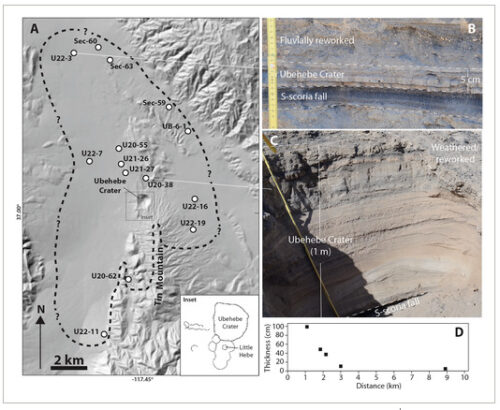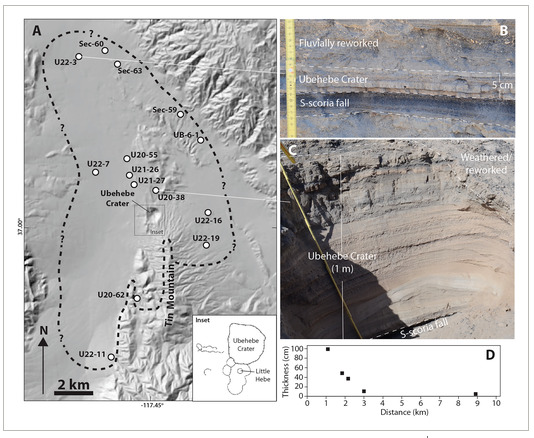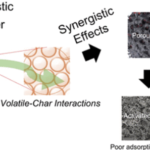UB の地質学者 Greg Valentine 氏が率いる研究の結果は、人命とインフラの保護に役立つ政策変更につながる可能性があります。 Findings from a study, led by UB geologist Greg Valentine, could lead to policy changes that help save lives and infrastructure
2023-01-06 バッファロー大学(UB)
この研究「Lateral Extent of Pyroclastic Surge Deposits at Ubehebe Crater (Death Valley, California) and Implications for Hazards in Monogenetic Volcanic Fields」は、10月にアメリカ地球物理学連合のGeophysical Research Lettersにオンラインで発表されました。
多くの爆発的噴火は、高温の溶岩と地下水の相互作用によって引き起こされます。このような噴火では、火砕流と呼ばれるガスや粒子が地面を巻き上げるような流れが発生することがあります。歴史的に、地質学者は、火砕流がもたらす危険性を噴火地点から0.1~4マイルの範囲と評価してきました。この予測は、火山地帯で過去に噴火した際に保存されていた地質学的な堆積物に基づいている。
しかし、カリフォルニア州のデスバレーにあるウベヘベ・クレーターで行われたバレンタイン氏の調査では、サージ堆積物が6マイル近くまで広がっていることが確認されている。
ヴァレンタイン氏は、「これまでのサージ流出距離の研究では、類似の噴火が発生した火山の堆積物に基づく、その時点で入手可能な最良のデータを使用していました」と述べています。”これらのほとんどは、数キロメートルを使用していましたが、ここでは、ちょうどデスバレーの保存状態が良いため、より広い範囲の影響を示す証拠を見ることができます。”
バレンタイン氏は、今後の火山地帯の危険度評価では、約9マイルまでの流出を許容し、火山の噴火が予想される場合の避難計画では、市民リーダーはその数字を考慮すべきであると提言しています。
火山サージは、流速が遅く、温度が比較的低い場合でも、人間や動物に窒息や火傷の危険をもたらし、空気取り入れ口や内燃機関などのインフラに損傷を与える可能性があります。したがって、このような火山活動にさらされる可能性のある地域の危険度評価と緊急時計画には、高潮の潜在的な到達範囲をより現実的に推定することが極めて重要です。
<関連情報>
- https://www.buffalo.edu/news/releases/2023/01/003.html
- https://agupubs.onlinelibrary.wiley.com/doi/10.1029/2022GL100561
ウベヘベ火口(カリフォルニア州デスバレー)における火砕サージ堆積物の横方向の広がりと単成火山地帯のハザードへの示唆。 Lateral Extent of Pyroclastic Surge Deposits at Ubehebe Crater (Death Valley, California) and Implications for Hazards in Monogenetic Volcanic Fields
Greg A. Valentine, Judy Fierstein, James D. L. White
Geophysical Research Letters Published: 21 October 2022
DOI:https://doi.org/10.1029/2022GL100561

Abstract
Hazard assessments in monogenetic volcanic fields require estimates of the runout of pyroclastic surges that result from phreatomagmatic explosive activity. Previous assessments used runout distances of 1–4 km, with large cases up to 6 km. Surge deposits at Ubehebe Crater (∼2100 y.b.p., Death Valley, California) have been traced ∼9 km from the crater center, and likely originally extended 1–3 km farther. There is no evidence that the Ubehebe Crater activity was unusually energetic; rather, its distal deposits are better preserved than those at most maar volcanoes because of its young age and the arid environment. Numerical simulations illustrate how low temperatures facilitate long runout of phreatomagmatic surges due to reduced expansion of entrained air compared to hot surges, allowing cool surges to retain higher densities than ambient air. We suggest that hazard assessments for volcanic fields with phreatomagmatic, maar-forming eruptions should consider runout distances in the range of 10–15 km.
Key Points
- Hazard assessments in monogenetic volcanic fields have considered pyroclastic surge runout up to 6 km based upon preserved deposits of previous eruptions
- Surge deposits from Ubehebe Crater extend to 9 km; this may not be unusual and such surges may have long runout facilitated by their low temperatures
- We suggest that future hazard assessments in monogenetic volcanic fields consider pyroclastic surge runout up to 10–15 km
Plain Language Summary
Assessments of volcanic hazards in areas prone to small-volume basaltic volcanoes includes consideration of the lateral extent of devastating pyroclastic surges from eruptions that are caused by magma-water explosions. Previous assessments considered surge distances up to 6 km, but the deposits from Ubehebe Crater (Death Valley, California, USA) have been traced to 9 km and likely originally extended farther. This was not an unusual eruption, but its deposits are exceptionally preserved due to the arid environment. Pyroclastic surges from magma-water explosions are likely to be cooler than other volcanic flows, and this facilitates long travel distances and hence far-reaching potential impacts if the area is inhabited. We suggest that future assessments should consider pyroclastic surge distances of 10–15 km from the vent.




